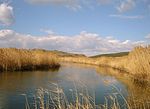Pitane (Aeolis)
Pitane (Ancient Greek: Πιτάνη), near Çandarlı, Turkey, was an ancient Greek town of the ancient region of Aeolis, in Asia Minor. It was situated near the mouth of the river Evenus on the bay of Elaea. It was one of the eleven ancient Aeolian settlements and possessed considerable commercial advantages in having two harbours. It was the birthplace of the academic philosopher Arcesilaus, and in the reign of Titus it suffered severely from an earthquake. The town is still mentioned by Hierocles. Pliny the Elder mentions in its vicinity a river Canaius, which is not noticed by any other writer; but it may possibly be the river Pitanes, spoken of by Ptolemy, and which seems to derive its name from the town of Pitane.Its site is near modern Çandarlı, Asiatic Turkey.
Excerpt from the Wikipedia article Pitane (Aeolis) (License: CC BY-SA 3.0, Authors).Pitane (Aeolis)
Fener Sk.,
Geographical coordinates (GPS) Address Nearby Places Show on map
Geographical coordinates (GPS)
| Latitude | Longitude |
|---|---|
| N 38.928055555556 ° | E 26.937222222222 ° |
Address
Fener Sk.
Fener Sk.
35980 (Çandarlı Mahallesi)
Turkey
Open on Google Maps

